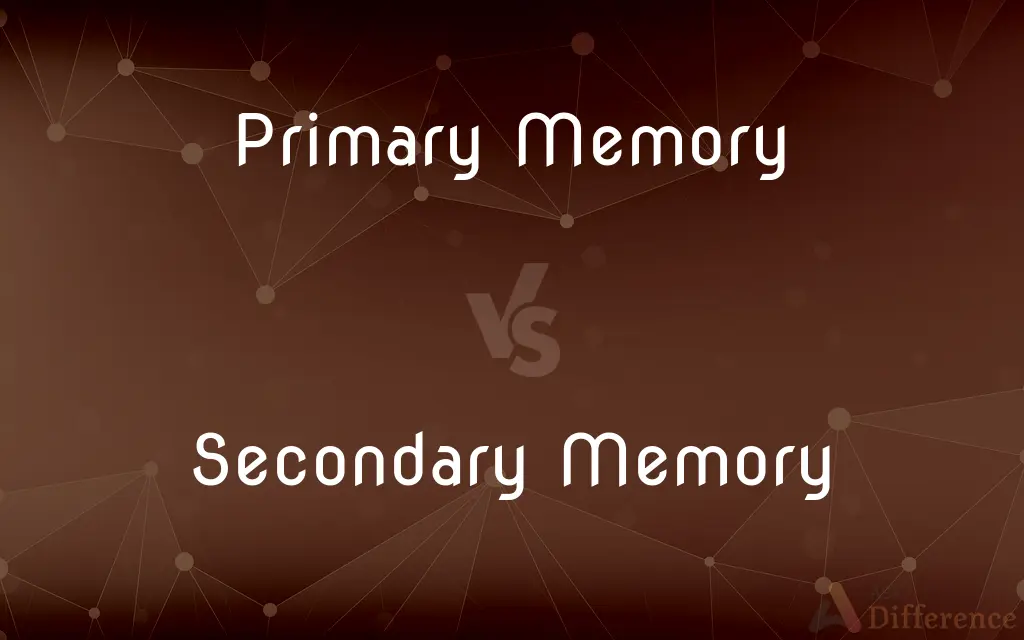Primary Memory vs. Secondary Memory — What's the Difference?
By Tayyaba Rehman — Published on November 28, 2023
Primary Memory is volatile and provides temporary storage, while Secondary Memory is non-volatile and offers permanent storage.

Difference Between Primary Memory and Secondary Memory
Table of Contents
ADVERTISEMENT
Key Differences
Primary Memory, often referred to as main memory, directly interacts with the central processing unit (CPU) and holds data for immediate processing. Secondary Memory, on the other hand, functions as a more long-term storage solution, storing data and information for prolonged durations.
Primary Memory includes components like Random Access Memory (RAM) and Cache Memory, which are crucial for a computer's speed and efficiency. Secondary Memory comprises devices like hard drives, SSDs, and CDs, which are essential for saving files, operating systems, and application software.
The data stored in Primary Memory is temporary and gets lost once the power is off, emphasizing its volatile nature. In contrast, Secondary Memory retains its stored data even after the system is powered down, signifying its non-volatile nature.
While Primary Memory offers rapid access times, making it ideal for quick data processing tasks, Secondary Memory typically has slower access times but offers larger storage capacities.
Comparison Chart
Nature
Volatile
Non-volatile
ADVERTISEMENT
Purpose
Immediate processing & temporary storage
Long-term storage of data
Examples
RAM, Cache Memory
Hard drives, SSDs, CDs
Data Retention
Loses data when power is off
Retains data even when power is off
Access Speed
Fast
Slower compared to Primary Memory
Compare with Definitions
Primary Memory
Provides temporary storage for running programs.
When you open a software program, it's loaded into Primary Memory for as long as it's in use.
Secondary Memory
Offers larger storage capacities compared to Primary Memory.
Movies and extensive databases are stored in Secondary Memory due to its vast space.
Primary Memory
Crucial for a system's speed and processing capabilities.
Systems with more Primary Memory can handle multitasking more efficiently.
Secondary Memory
Comprises devices like hard drives and SSDs.
To increase storage capacity, one might upgrade their Secondary Memory with a larger hard drive.
Primary Memory
The main memory directly accessible by the CPU.
When running applications, they're loaded into Primary Memory for quick access.
Secondary Memory
Used for long-term data storage.
All the files on your desktop are stored in the computer's Secondary Memory.
Primary Memory
Consists of components like RAM and Cache.
Upgrading the RAM, a type of Primary Memory, can boost a computer's performance.
Secondary Memory
Doesn't directly interact with the CPU.
When you run a program, it's first fetched from Secondary Memory and then loaded into Primary Memory.
Primary Memory
Volatile storage that loses data when powered off.
If a computer unexpectedly shuts down, unsaved work in Primary Memory is lost.
Secondary Memory
Non-volatile storage that retains data without power.
After saving a document, it's stored in Secondary Memory, ensuring its safety even if the computer turns off.
Common Curiosities
What does Secondary Memory refer to?
Secondary Memory refers to non-volatile storage devices, like hard drives or SSDs, used for long-term data storage.
Can I increase my computer's performance by expanding its Secondary Memory?
While expanding Secondary Memory gives more storage, it's the enhancement of Primary Memory (like RAM) that boosts performance.
How does data travel between Primary and Secondary Memory?
Data is fetched from Secondary Memory and loaded into Primary Memory for processing and then saved back to Secondary Memory.
Why is Primary Memory called volatile?
Primary Memory is called volatile because it loses its stored data when the power is turned off.
What is Primary Memory?
Primary Memory, or main memory, is the computer's temporary and volatile storage that interacts directly with the CPU.
What happens to the programs in Primary Memory when a computer is restarted?
All data in Primary Memory is erased, and programs need to be reloaded from Secondary Memory after a restart.
Can I run software without sufficient Primary Memory?
Insufficient Primary Memory might cause software to run slowly or not at all, relying on slower Secondary Memory.
What is the primary purpose of Secondary Memory?
The primary purpose of Secondary Memory is to provide long-term storage for data and programs.
Why doesn't Secondary Memory interact directly with the CPU?
Due to its slower access times compared to Primary Memory, Secondary Memory doesn't interact directly to ensure efficient processing.
Are USB drives considered Primary or Secondary Memory?
USB drives are forms of Secondary Memory used for data storage.
Are CDs and DVDs considered Secondary Memory?
Yes, CDs and DVDs serve as forms of Secondary Memory for data storage.
Is Cache Memory a form of Primary Memory?
Yes, Cache Memory is a high-speed form of Primary Memory that stores frequently accessed data.
Is it possible to upgrade both Primary and Secondary Memory in a computer?
Yes, both Primary (like RAM) and Secondary Memory (like hard drives) can often be upgraded, though compatibility and system specifications must be considered.
Why is RAM an example of Primary Memory?
RAM allows for quick read and write access, serving as temporary storage for immediate data processing.
How does Secondary Memory differ in structure from Primary Memory?
While Primary Memory consists of electronic circuits (like RAM chips), Secondary Memory uses magnetic or optical storage mechanisms (like hard drives or CDs).
Share Your Discovery

Previous Comparison
Magnesium vs. Magnesium Glycinate
Next Comparison
Liquid Ammonia vs. Liquor AmmoniaAuthor Spotlight
Written by
Tayyaba RehmanTayyaba Rehman is a distinguished writer, currently serving as a primary contributor to askdifference.com. As a researcher in semantics and etymology, Tayyaba's passion for the complexity of languages and their distinctions has found a perfect home on the platform. Tayyaba delves into the intricacies of language, distinguishing between commonly confused words and phrases, thereby providing clarity for readers worldwide.












































